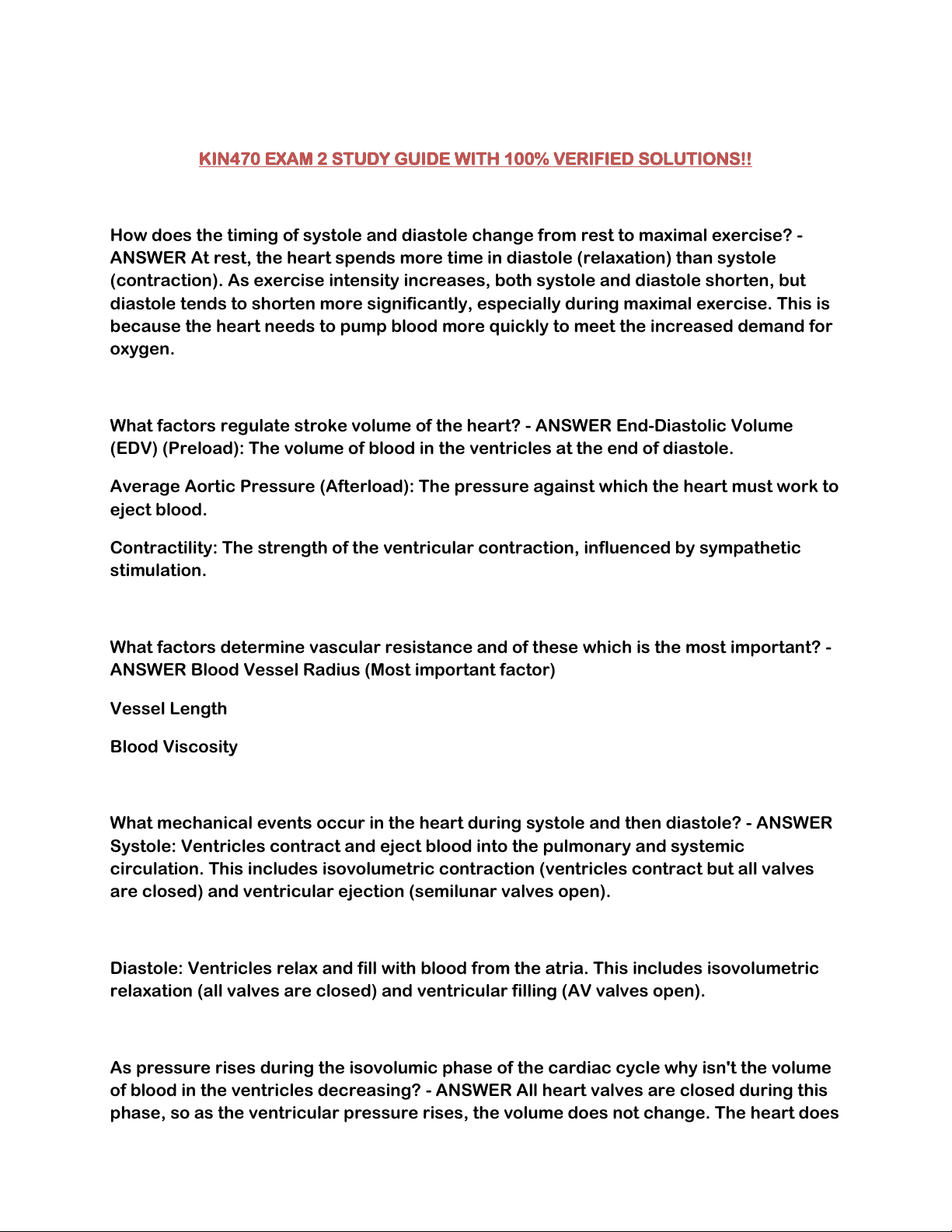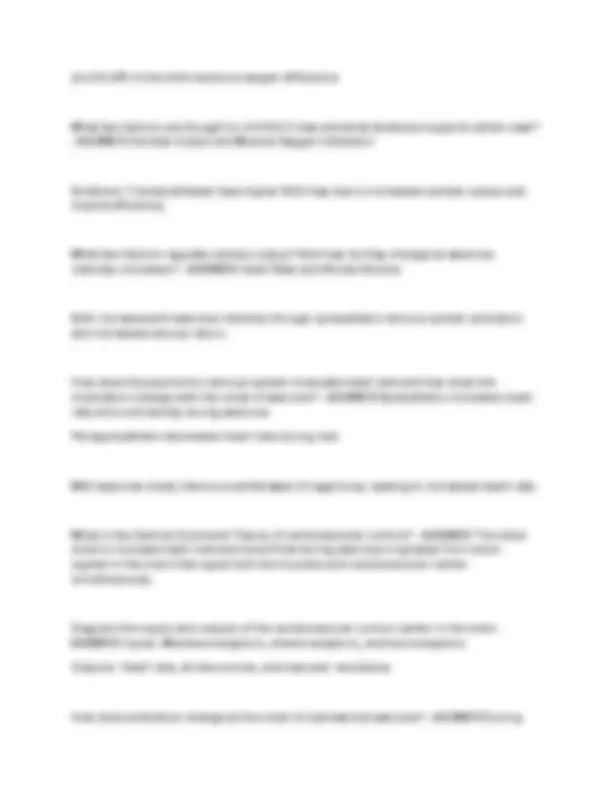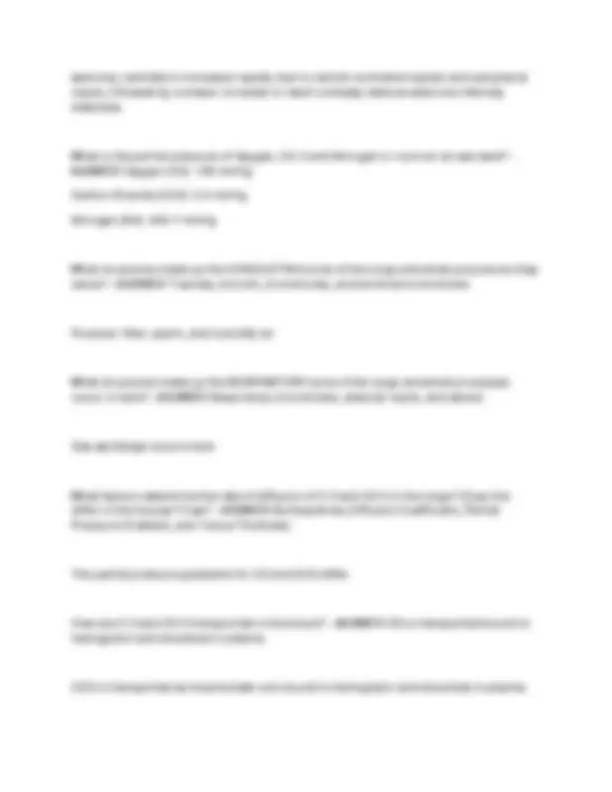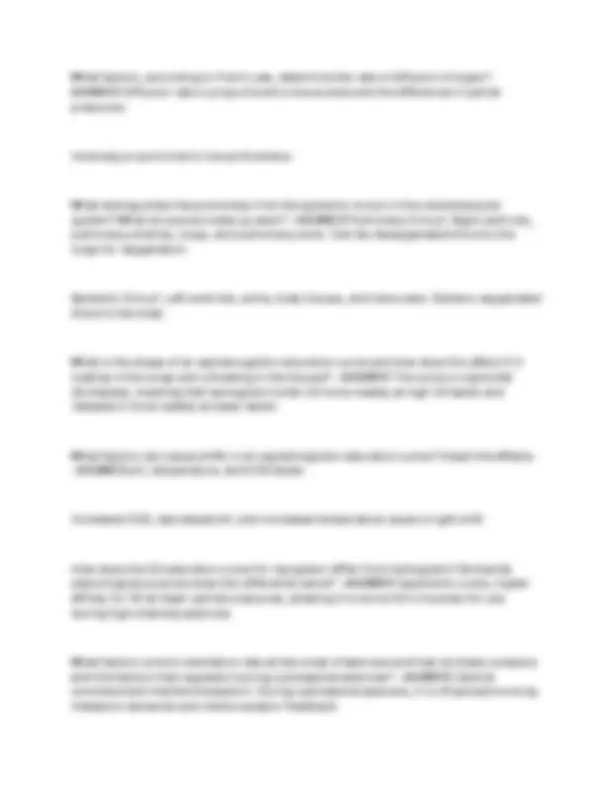





Study with the several resources on Docsity

Earn points by helping other students or get them with a premium plan


Prepare for your exams
Study with the several resources on Docsity

Earn points to download
Earn points by helping other students or get them with a premium plan
Community
Ask the community for help and clear up your study doubts
Discover the best universities in your country according to Docsity users
Free resources
Download our free guides on studying techniques, anxiety management strategies, and thesis advice from Docsity tutors
KIN470 EXAM 2 STUDY GUIDE WITH 100% VERIFIED SOLUTIONS!!
Typology: Exams
1 / 6

This page cannot be seen from the preview
Don't miss anything!




How does the timing of systole and diastole change from rest to maximal exercise? - ANSWER At rest, the heart spends more time in diastole (relaxation) than systole (contraction). As exercise intensity increases, both systole and diastole shorten, but diastole tends to shorten more significantly, especially during maximal exercise. This is because the heart needs to pump blood more quickly to meet the increased demand for oxygen.
What factors regulate stroke volume of the heart? - ANSWER End-Diastolic Volume (EDV) (Preload): The volume of blood in the ventricles at the end of diastole.
Average Aortic Pressure (Afterload): The pressure against which the heart must work to eject blood.
Contractility: The strength of the ventricular contraction, influenced by sympathetic stimulation.
What factors determine vascular resistance and of these which is the most important? - ANSWER Blood Vessel Radius (Most important factor)
Vessel Length
Blood Viscosity
What mechanical events occur in the heart during systole and then diastole? - ANSWER Systole: Ventricles contract and eject blood into the pulmonary and systemic circulation. This includes isovolumetric contraction (ventricles contract but all valves are closed) and ventricular ejection (semilunar valves open).
Diastole: Ventricles relax and fill with blood from the atria. This includes isovolumetric relaxation (all valves are closed) and ventricular filling (AV valves open).
As pressure rises during the isovolumic phase of the cardiac cycle why isn't the volume of blood in the ventricles decreasing? - ANSWER All heart valves are closed during this phase, so as the ventricular pressure rises, the volume does not change. The heart does
not eject blood yet because it's building pressure to be greater than the aortic pressure before the semilunar valves open.
How does stroke volume change as a function of exercise intensity? - ANSWER Stroke volume increases with exercise intensity up to a point and plateau, usually around 40-60% of VO2 max. For trained individuals, they do not plateau as their hearts adapted through training, allowing for greater ventricular filling and improved contractility.
Further increases in cardiac output are primarily achieved through increased heart rate rather than stroke volume.
What substrates (a.k.a. fuel) does the myocardium (heart) use? How does this change as a function of exercise intensity? - ANSWER Rest: Fatty Acids
Moderate: Glucose
Maximal: Lactate
What factors lead to enhanced end-diastolic volume during exercise? - ANSWER Increased venous return due to the skeletal muscle pump and respiratory pump.
Venoconstriction due to sympathetic nervous system activation.
Enhanced blood flow and filling time at lower exercise intensities.
What is the Frank-Starling law of the heart and how does it affect contractility (strength of contraction) and what is the underlying molecular mechanism of this effect? - ANSWER The strength of ventricular contraction increases with the amount of blood filling the ventricles (EDV). The stretching of myocardial fibers, which increase the interaction between actin and myosin filaments, enhancing contraction force.
What is the Fick Equation? - ANSWER VO2 = Q x (a-vO2 diff)
VO2 is oxygen consumption
Q is cardiac output
exercise, ventilation increases rapidly due to central command signals and peripheral inputs, followed by a slower increase to reach a steady state as exercise intensity stabilizes.
What is the partial pressure of Oxygen, CO 2 and Nitrogen in room air at sea level? - ANSWER Oxygen (O2): 159 mmHg
Carbon Dioxide (CO2): 0.3 mmHg
Nitrogen (N2): 600.7 mmHg
What structures make up the CONDUCTING zone of the lungs and what purpose do they serve? - ANSWER Trachea, bronchi, bronchioles, and terminal bronchioles.
Purpose: filter, warm, and humidify air
What structures make up the RESPIRATORY zone of the lungs and what processes occur in here? - ANSWER Respiratory bronchioles, alveolar ducts, and alveoli.
Gas exchange occurs here.
What factors determine the rate of diffusion of O 2 and CO 2 in the lungs? Does this differ in the tissues? How? - ANSWER Surface Area, Diffusion Coefficient, Partial Pressure Gradient, and Tissue Thickness.
The partial pressure gradients for O2 and CO2 differ.
How are O 2 and CO 2 transported in the blood? - ANSWER O2 is transported bound to hemoglobin and dissolved in plasma.
CO2 is transported as bicarbonate ions bound to hemoglobin and dissolved in plasma.
What factors, according to Fick's Law, determine the rate of diffusion of a gas? - ANSWER Diffusion rate is proportional to tissue area and the difference in partial pressures.
Inversely proportional to tissue thickness.
What distinguishes the pulmonary from the systemic circuit in the cardiovascular system? What structures make up each? - ANSWER Pulmonary Circuit: Right ventricle, pulmonary arteries, lungs, and pulmonary veins. Carries deoxygenated blood to the lungs for oxygenation.
Systemic Circuit: Left ventricle, aorta, body tissues, and vena cava. Delivers oxygenated blood to the body.
What is the shape of an oxyhemoglobin saturation curve and how does this affect O 2 loading in the lungs and unloading in the tissues? - ANSWER The curve is sigmoidal (S-shaped), meaning that hemoglobin binds O2 more readily at high O2 levels and releases it more readily at lower levels.
What factors can cause shifts in an oxyhemoglobin saturation curve? Graph the effects.
Increased CO2, decreased pH, and increased temperature cause a right shift.
How does the O2 saturation curve for myoglobin differ from hemoglobin? And what physiological purpose does this difference serve? - ANSWER Hyperbolic curve, higher affinity for O2 at lower partial pressures, allowing it to store O2 in muscles for use during high-intensity exercise.
What factors control ventilation rate at the onset of exercise and how do these compare with the factors that regulate it during submaximal exercise? - ANSWER Central command and mechanoreceptors. During submaximal exercise, it is influenced more by metabolic demands and chemoreceptor feedback.